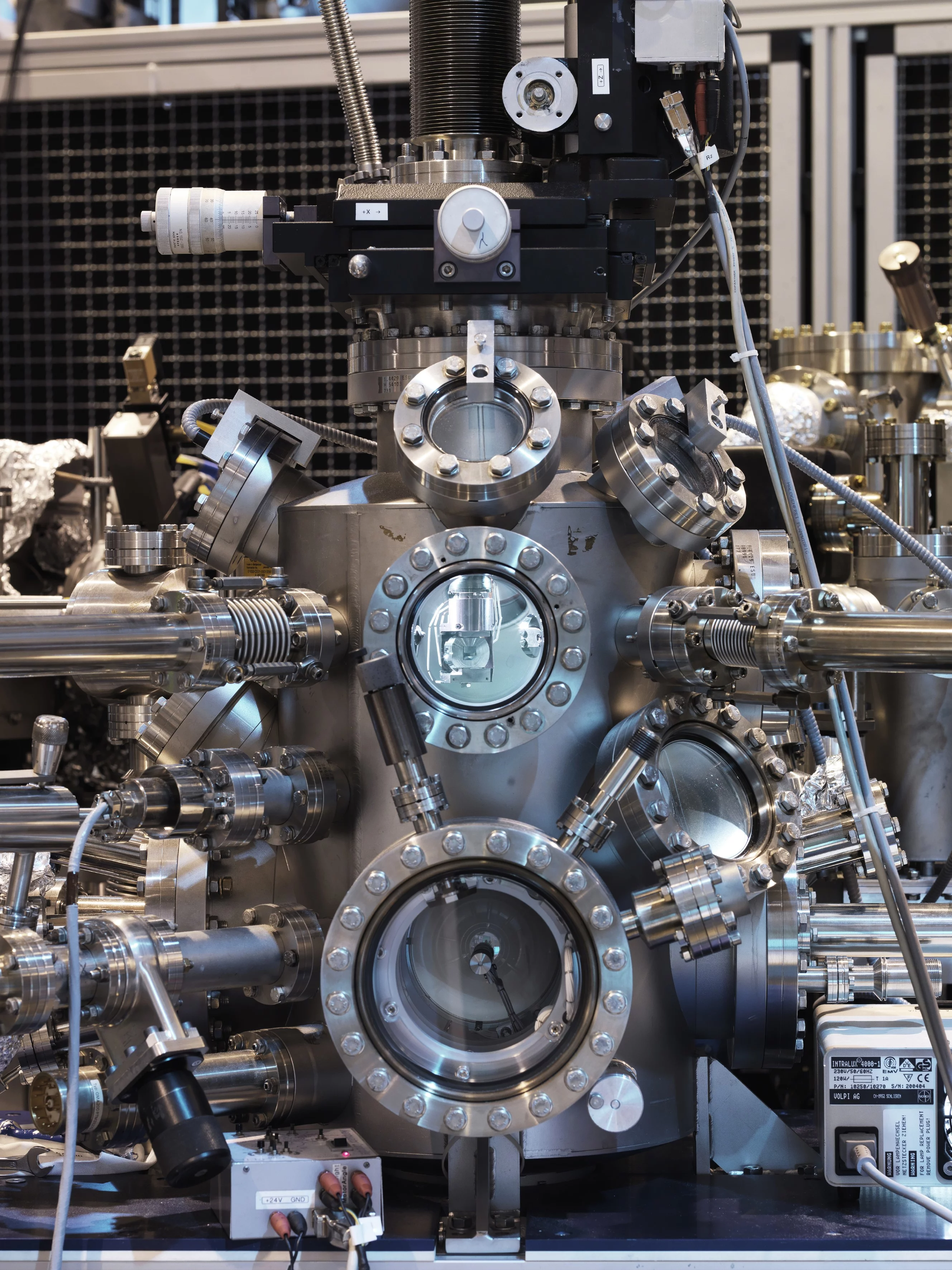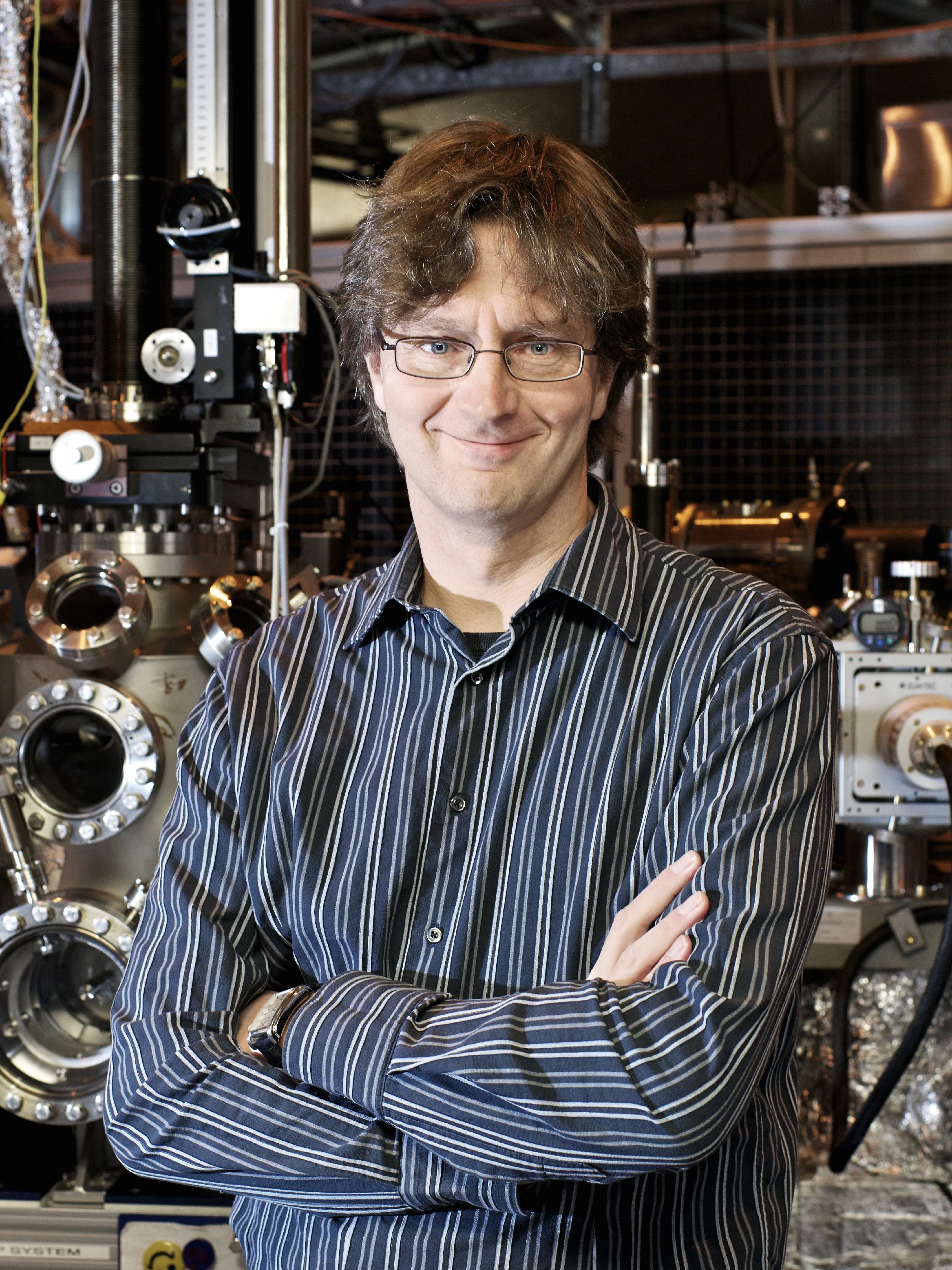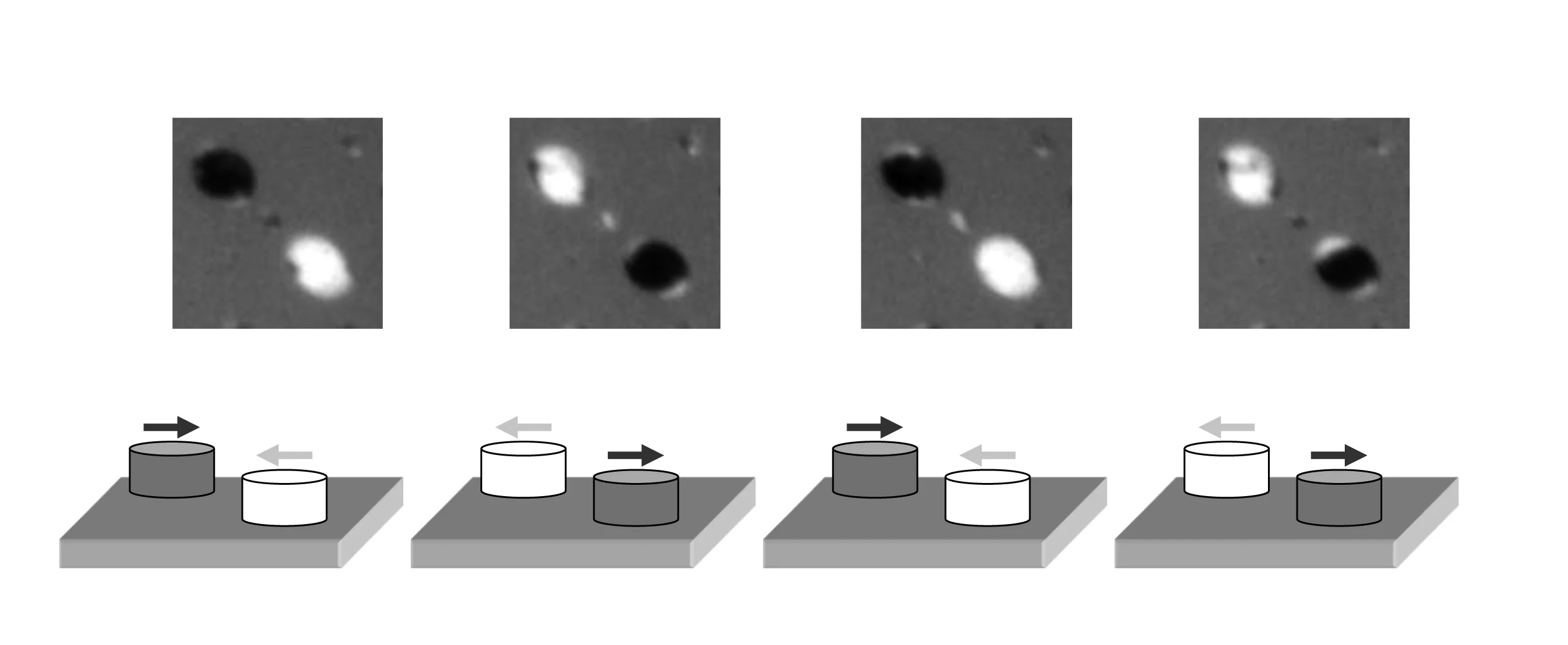Computer hard drives store data magnetically as long sequences of noughts and ones. For increasingly more compact storage media of the future, these magnetic areas – the memory bits – also need to be increasingly smaller. But just how small can a magnet be? Once the nanoscale has been reached, a material’s properties sometimes change out of the blue. Frithjof Nolting is a nanoscientist at the Paul Scherrer Institute (PSI). Together with his colleagues, he pursues everyday and bizarre nanomagnetic phenomena.
The shiny, silver monster hangs on a muddle of wires, pipes and tubes; a cumbersome entity that looks like a broken cyborg in hospital. But we’re actually in the hall of the Swiss Light Sources (SLS) at PSI and the silver beast is neither a cyborg nor on the blink: it’s the experimentation chamber belonging to Frithjof Nolting’s research group.
Study materials that enter this silvery vacuum chamber are exposed to powerful x-rays from the SLS – and sometimes an ultra-short, intensive laser, too. The x-rays render the magnetisation of minuscule particles visible – which is what Nolting is interested in. And he is also a specialist in laser beams. The physicist describes himself as a nanoscientist or, to be more precise, a researcher of nanomagnetism. One nanometre is equivalent to one billionth of a metre – or one millionth of a millimetre – and roughly corresponds to the diameter of our DNA.
The term nano
has seen a meteoric rise in science in recent decades. While the word has also hit the headlines in the popular scientific media, it is not used particularly consistently. For Nolting, a definition is therefore important: For me, nanoscience means that the properties of a material are different due to the small size of the particles.
Nano-silver, for instance, has antibacterial properties; normal silver doesn’t.
How small can a magnet be?
Nolting’s research begins in this range, where size helps govern the properties: This is where it gets exciting for me.
However, he does not deal with precious silver, but rather plain, old iron – which is magnetic. Many of Nolting’s questions are of a fundamental nature: how do the magnetic properties of a material change when it exists as a nanostructure? How small can a magnet be made? And might this be used to store considerably more data on computer hard drives one day?
For me, the computer hard drive is a shining example of nanotechnology,
swoons Nolting. This is because hard drives save information magnetically as a long sequences of noughts and ones. A zero
corresponds to the magnetisation of a tiny area in one direction, a one
in the opposite direction. A magnetic head travels across the hard drive – much like the needle on a record player, albeit at breakneck speed – and reads the direction of magnetisation of the individual bits and therefore the data. Today, a commercially available hard drive with one terabyte of memory contains trillions of such tiny magnetic bits. The same magnetic head is also used to change the magnetisation precisely and thus save data.
From the tiniest magnets to memory bits
However, magnetism is a group phenomenon. In a magnetic material, every single atom is a kind of infinitely small magnet. A large number of these atomic magnets are aligned with one another in the same direction, thereby forming a tiny magnetic kernel – which researchers refer to as a magnetic domain.
Every magnetic material – and therefore also the bits on the hard drive – comprises many of these domains. And it needs a certain number of equally aligned domains, which mutually stabilise each other. One single, small domain would change constantly and uncontrolledly, and the data stored would be lost. In other words: you can’t make a magnet as small as you want.
Nolting and his colleagues set about testing this boundary by studying the magnetic alignment of different-sized iron nanoparticles. Inside the bulky, silver experimentation chamber, synchrotron beams from the SLS render the magnetism visible. This generates an image of the sample where the material appears white when magnetised in one direction and black when the magnetisation points in the opposite direction. The researchers studied their iron nanoparticles, spread over a surface, for a certain period of time. The early days of cinema must have looked similar: rough outlines, a blurred picture, no colours and, of course, no sound.
What would barely pass as entertainment, however, produced an astonishing result for the scientists. While, as expected, a number of particles kept changing their magnetisation, which showed up in grey on the monitors – a mixture of black and white – others remained stable for several minutes: either black or white. And even more surprisingly, this result was independent of the size of the nanoparticles, which were between 8 and 20 nanometres in diameter. Even when a nanoparticle comprises one single domain – which is the case below roughly 12 nanometres – it can enter a state where, for reasons that still remain a mystery, its magnetism remains stable for a while. For now, however, data cannot really be stored on it permanently.
Smaller bits need to be more stable
The next logical step for smaller bits would therefore be a magnetically more consistent, stable material. Such materials are referred to as magnetically harder. The magnetic hardness of every material can be determined.
First of all, Nolting and his team experimented with an alloy made of iron, gadolinium and cobalt, which is magnetically softer than pure iron but offers interesting possibilities. In iron gadolinium cobalt, the iron’s strong magnetic moment dictates the magnetic alignment of the entire bit. Gadolinium has a weak, opposing direction of magnetisation. Together, this system determines the particular magnetic properties of iron gadolinium cobalt.
The PSI researchers used the material to produce miniscule, flat squares in a regular arrangement on a smooth subsurface. While the squares were not quite in the nanometre range, the scientists were able to experiment well with micrometre-sized squares.
More stable magnetisation requires stronger switching
A stronger medium than the magnetic head on a commercially available hard drive is required to switch the magnetisation of hard magnetic bits specifically. As a result, Nolting and his colleagues looked to test alternative methods. And the micro-squares were their first guinea pigs.
This is where the aforementioned laser comes in. Nolting and his colleagues stumbled across a research result from 2007: scientists from the Netherlands and Japan had demonstrated that magnetisation could also be altered with light – short pulses of circularly polarised laser light, to be more precise. With this light, the polarisation, i.e. the direction of the electrical light field, keeps turning in a circle.
Nolting and his workgroup initially attempted to recreate the Dutch and Japanese scientists’ result. Although circularly polarised light can be obtained relatively easily, it is complicated to handle in the experiment. As we were frustrated by the difficulties we were having, we half-jokingly fired normally polarised laser pulses onto our sample,
explains Nolting. To their astonishment, the experiment still worked: the magnetic alignment of the sample could be changed specifically.
Switching with the laser pulse
A new explanatory model was needed. And Nolting and his colleagues provided one – even if it is not yet fully complete. As their preliminary explanation reads: the effect is an interplay between the special material iron gadolinium cobalt, which Nolting’s micro-structures are made of, and the use of ultra-short laser pulses. The latter warms up the material extremely rapidly and the heat triggers a reversal of the magnetisation: in the interaction between the three metals, the iron switches its magnetisation somewhat more quickly than the gadolinium and reverses its magnetisation. As both are magnetised in opposite directions in their basic state, they are briefly aligned in parallel once the laser pulse arrives. In order to return to the more stable state, the magnetisation of the gadolinium eventually switches round. And because the magnetisation of the iron dominates the entire compound, the magnetisation of the micro-structure has now been reversed – using nothing more than rapid, pinpoint heat.
At least according to the theoretical model. But the jury is still out, admits Nolting: I wouldn’t be surprised if the correct explanation were completely different in the end.
Laser pulse leaves behind bizarre patterns
In order to get to the bottom of the matter, the PSI researchers went a step further: they wanted to make a kind of film in slow motion while the magnetisation of their micro-squares changes due to the laser pulse.
The researchers knew that the diameter of the laser beam was much larger in their experiment than their iron gadolinium cobalt squares. Therefore, the laser pulse would irradiate many of the tiny squares at the same time.
Consequently, Nolting and his team were stunned by the result of the measurement: the magnetisation had not reversed evenly in the individual micro-squares. Instead, magnetic substructures formed within the illuminated squares. The black patterns against a white background revealed that the heat from the laser pulse was evidently absorbed more strongly in individual parts of the tiny squares than in others. And the pattern itself was also peculiar: it resembled the Batman logo.
Where there’s a pattern, other shapes are also possible
While this quirk of nature brought a smile to the researchers’ faces, in actual fact real science is lurking under the surface here. After all, if a bat logo can be created, other magnetic shapes are also possible. The individual pattern develops in a complex interplay between the microstructure and the laser pulse. The essence: only a subsection of the microstructure changes its magnetisation. Therefore, not only can every single micro-square be used as a memory bit; one day, every subsection might be a bit. In a nutshell: data can be packed even more tightly than the researchers anticipated at the beginning of their experiments.
And the scientists at PSI already have the first evidence that their experiments also work with nanostructures as well as their micro counterparts. The future will bring ever smaller memory bits. And Nolting and the silver monster at PSI are playing their part.
Text: Paul Scherrer Institut/Laura Hennemann
Additional information (media releases)
Using heat for storing dataBatman lights the way to compact data storage
Contact
Prof. Dr. Frithjof NoltingLaboratory for Synchrotron Radiation – Condensed Matter Physics
Paul Scherrer Institute, 5232 Villigen PSI, Switzerland
Telephone: +41 56 310–5111, E-Mail: frithjof.nolting@psi.ch



